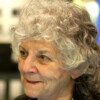Ada Yonath

Ada Yonath
Ada E. Yonath is an Israeli crystallographer best known for her pioneering work on the structure of the ribosome. She is the current director of the Helen and Milton A. Kimmelman Center for Biomolecular Structure and Assembly of the Weizmann Institute of Science. In 2009, she received the Nobel Prize in Chemistry along with Venkatraman Ramakrishnan and Thomas A. Steitz for her studies on the structure and function of the ribosome, becoming the first Israeli woman to win the Nobel...
NationalityIsraeli
ProfessionScientist
Date of Birth22 June 1939
CityGeula, Israel
CountryIsrael
My parents were Zionists born in Poland. My father was a rabbi who didn't know much about science and ran a grocery store in the neighborhood with my mother's help.
My memories from my childhood are centered on my father's medical conditions alongside my constant desire to understand the principles of the nature around me.
I was described as a dreamer, a fantasist, even as the village idiot. I didn't care. What I cared about was convincing people to allow me to go on with my work.
I wanted to reveal how genetic code is translated into protein. I knew a great application could be for antibiotics, since half of the useful ones target the ribosomes, but I didn't believe I could contribute to it. It was like the next Mount Everest to conquer. It was my dream to contribute something to humanity.
I used ribosomes from very, very robust bacteria under very, very active conditions and found a way - I actually took advantage of research done before me at the Weizmann, the same institute I am now - how to preserve their activity and their integrity while they crystallized.
I don't walk into the lab in the morning thinking, 'I am a woman, and I will carry out an experiment that will conquer the world.' I am a scientist, not male or female. A scientist.
From the age of 11, I was cleaning floors, washing dishes, making sandwiches and being a cashier. Survival was the name of the game. Life was so hard that I had to struggle to keep up my standards. Under these conditions, I didn't think about science too much.
For quite a while, I didn't receive a higher academic status. I didn't feel any discrimination against me as a woman scientist, but I hadn't produced a lot of science journal articles.
There are over 7,000 different types of proteins in typical eukaryotic cells; the total number depends on the cell class and function.